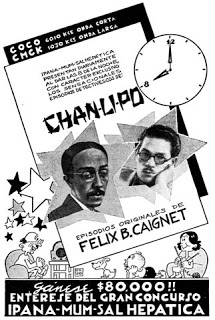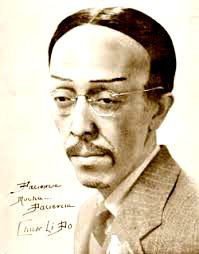The story is usually capricious and there are beings who are born signed to shine. This was the case of Félix Benjamín Caignet, who in his veins carried French and Cuban blood and who progressively unfolded his artistic potential to an unusual versatility and fullness.
Already in 1933, in Santiago de Cuba, this innate narrator had become whole when he inaugurated the first episodic story oriented to children and adolescents in Ibero-America, called “The Adventures of Shilling and Bebita” and shortly after it was the turn of the ” Adventures of Chan Li Po “, first exponent of the detective genre written by Cubans, starting from the North American series.
Theatrical promoter, journalist, reporter, playwright, poet, painter, composer, are just some of the aspects of his art. However, he still had much to say and he still had much to give Caignet to Cuba.
The story records the unprecedented communicative impact caused by the adventures of the Chinese detective when it premiered in Havana by O’Shea Broadcasting and as all daily activity was subordinated to it in surprising audiences.
The protagonist of the series, was Aníbal de Mar, the same Santiago who premiered it in Santiago de Cuba, next to Caignet and that later would be the central figure in the film version that today occupies us. By 1937, when a four-year period had elapsed since Mexico and Argentina had started their talking film industry, and in Cuba, they did not succeed in achieving the dissimilar attempts to this end.
He played “The Red Serpent,” the first of the series by Chan Li Po, which not only Caignet wrote, in both his radio and film versions – to promote our sound films, giving him not only the primacy of history, adapting His original work, but marking his debut as a screenwriter on the big screen.
For this, an unusual alliance was created when Luis R. Molina joined Félix O’Shea, owner of the radio station that premiered these episodes in Havana, to produce the film that becomes the first concrete result in our country of a spoken production , “Will say whether or not Cuba can establish the film industry”.
In the cast, starring Aníbal de Mar, were Pituka de Foronda (talented Spanish actress from the boards of the group “La Cueva”), Carlos Badias as young gallant, Dolores Zabala, Pedro Segarra, Aurelio Cavia, Ramón Valenzuela, Roberto Insua and Until the own Caignet like Talua, significant personage. In the technical team, Ernesto Caparrós took over the general direction and the sound and Laureano Rodríguez Gavaldón and Ricardo Delgado, corresponded the cameras, in a story with more than seven thousand feet of shooting (8 rolls). The filming took place mainly in the old Hotel Almendares, in the margins of the homonymous river.
The premiere took place in Havana, in May 1937; An occasion exploited by all elements of the Havana Cultural Industry. La Prensa Plana and the Radio were prodigated in notes, infomercials and even full color posters printed in the workshops of the Union of Arts Grafica S.A.
In spite of the complexity of a very complicated plot that combined diverse subplots, secrets, a familiar monster, a beautiful girl, a handsome judge, an unfriendly cousin and a “Mona Lisa”, the film caught the attention of the astonished patio filmmakers .
A year later came Cuban Films S.A. “PECUSA”, a Cuban film producer created among others by Ramón Peón, who would undertake collecting works in our cinematographic memorabilia, as they were to mention the first “Happened in Havana” and “Romance del Palmar”, where Cuban talent and Ibero-American, but that’s another story.
Primera Película Detectivesca Sonora Cubana “Las Aventuras de Chan Li Po”. Video.
La historia suele ser caprichosa y hay seres que nacen signados para brillar. Ese fue el caso de Félix Benjamín Caignet, quien en sus venas llevaba sangre francesa y cubana y que progresivamente desdobló sus potencialidades artísticas hasta alcanzar una versatilidad y plenitud inusual.
Ya en 1933, en Santiago de Cuba, este narrador innato se había volcado íntegro cuando inauguró la primera historia episódica orientada a niños y adolescentes en Ibero América, denominado “Las Aventuras de Chelín y Bebita” y poco después le tocó el turno a las “Aventuras de Chan Li Po”, primer exponente del género detectivesco escrito por cubanos, partiendo de las series norteamericanas.
Promotor teatral, periodista, reportero, dramaturgo, poeta, pintor, compositor, son sólo algunas de las vertientes de su arte. Sin embargo, aún le quedaba mucho por decir y aún tenía mucho por dar Caignet a Cuba.
La historia registra el impacto comunicativo sin precedentes que causaron las peripecias del detective chino al estrenarse en La Habana por Radiodifusión O’Shea y como toda la actividad cotidiana se supeditó a ella, en sorprendentes audiencias.
El protagonista de la serie, fue Aníbal de Mar, el mismo santiaguero que la estrenó en Santiago de Cuba, junto a Caignet y que después sería la figura central en la versión cinematográfica que hoy nos ocupa. Para 1937, cuando ya había transcurrido un cuatrienio desde que México y Argentina estrenaran su industria cinematográfica parlante y en Cuba no lograban concretarse los disímiles intentos encaminados a este fin.
Le tocó a “La serpiente roja”, la primera de las series de Chan Li Po, que no solo Caignet escribió, tanto en su versión radial como en la cinematográfica -inaugurar nuestros filmes sonoros, dándole no sólo la primacía de la historia, adaptando su obra original, sino marcando su debut como guionista en la pantalla grande.
Para ello, se creó una alianza insólita cuando Luis R. Molina se asoció a Félix O’Shea propietario de la emisora radial que estrenó estos episodios en La Habana, para producir el filme que deviene el primer resultado concreto en nuestro país de una producción hablada, “dirán si puede establecer o no en Cuba la industria cinematográfica”.
En el elenco, protagonizado por Aníbal de Mar, estaban Pituka de Foronda (talentosa actriz española de las tablas del grupo “La Cueva”), Carlos Badias como galán joven, Dolores Zabala, Pedro Segarra, Aurelio Cavia, Ramón Valenzuela, Roberto Insua y hasta el propio Caignet como Talua, significativo personaje. En el equipo técnico, tuvo a Ernesto Caparrós quien asumió la dirección general y el sonido y a Laureano Rodríguez Gavaldón y Ricardo Delgado, correspondieron las cámaras, en una historia con más de siete mil pies de rodaje (8 rollos). La filmación se efectuó principalmente en el antiguo Hotel Almendares, en las márgenes del río homónimo.
La premiere se produjo en La Habana, en Mayo de 1937; ocasión explotada por todos los elementos de la Industria Cultural habanera. La Prensa Plana y la Radio se prodigaron en notas, infomerciales y hasta afiches a todo color impresos en los talleres del Sindicato de Artes Grafica S.A.
Pese a la complejidad de una trama muy complicada que aunaba diversas sub tramas, secretos, un monstruo familiar, una bella muchacha, un juez apuesto, un primo antipático y una “Mona Lisa”, el film captó la atención de los asombrados cineastas del patio.
Un año más tarde surgió Películas Cubanas S.A. “PECUSA”, productora cinematográfica cubana creada entre otros por Ramón Peón, que acometería obras de colección en nuestra memorabilia cinematográfica, como fueron por mencionar a las primeras “Sucedió en La Habana” y “Romance del Palmar”, donde brillarían tanto talento cubano e iberoamericano, pero ya esa es otra historia.
Agencies/MGCubanHistory/Internet Photos/ YouTube/ Arnoldo Varona/ TheCubanHistory.com
THE CUBAN HISTORY, HOLLYWOOD.









